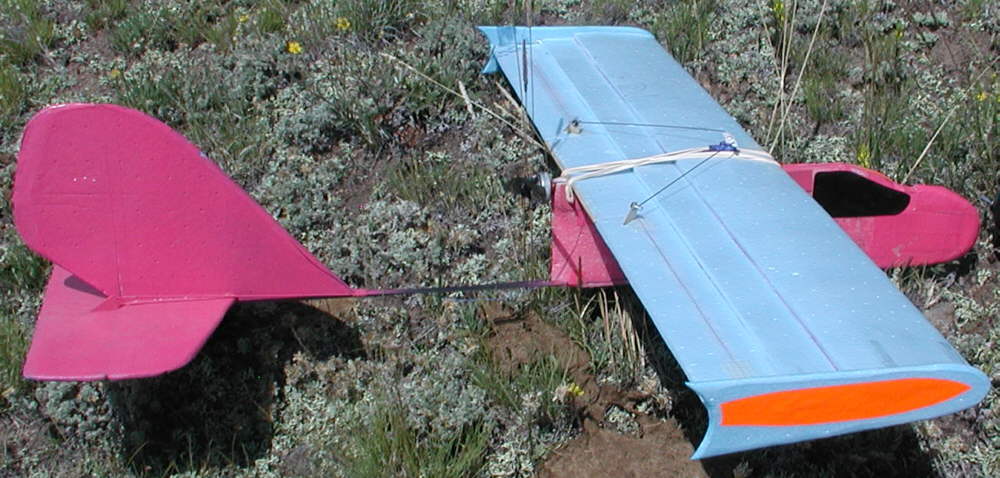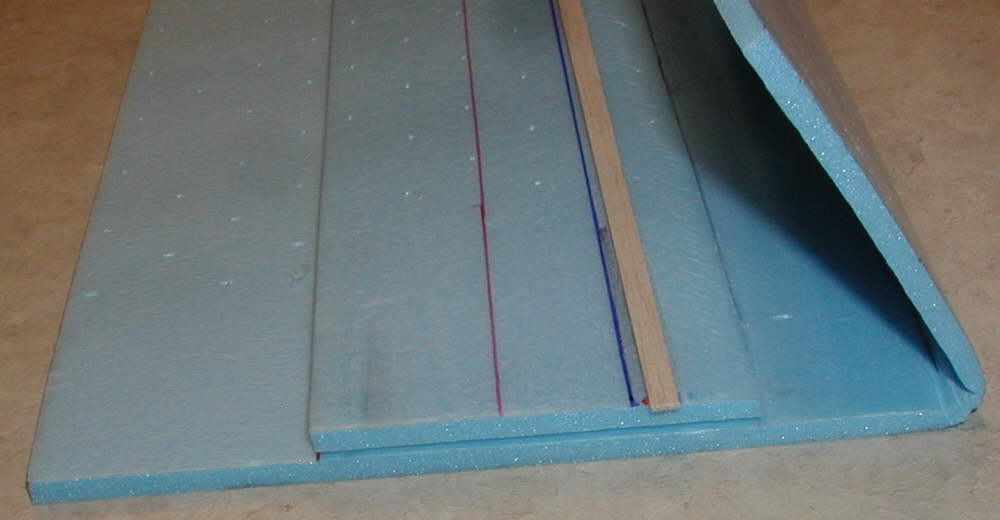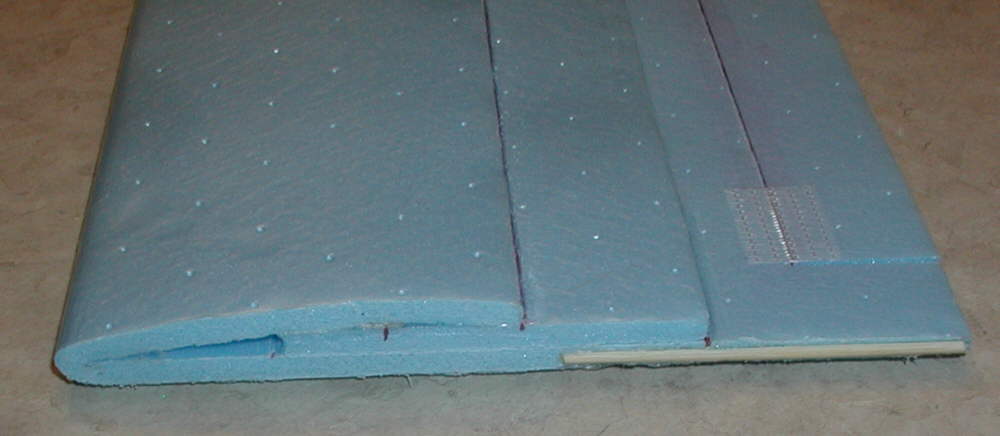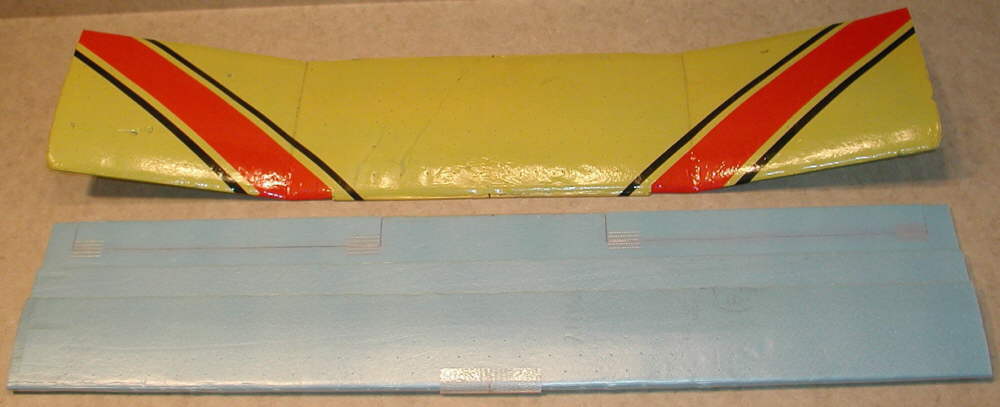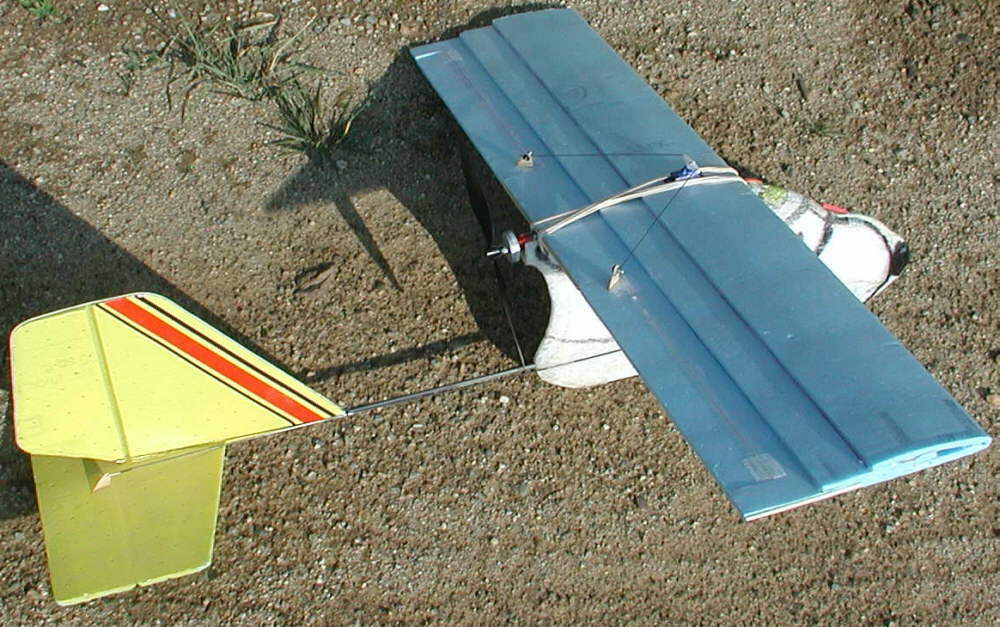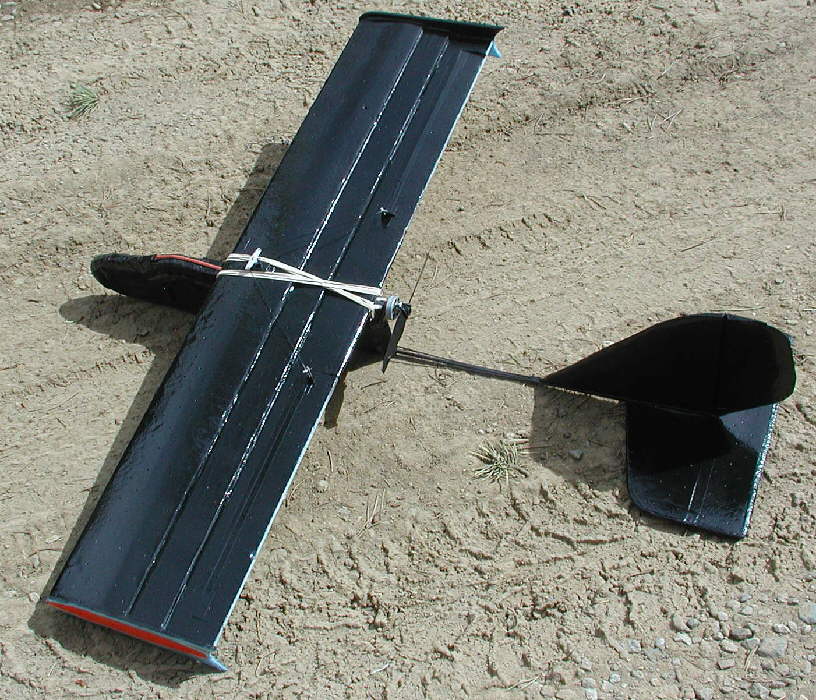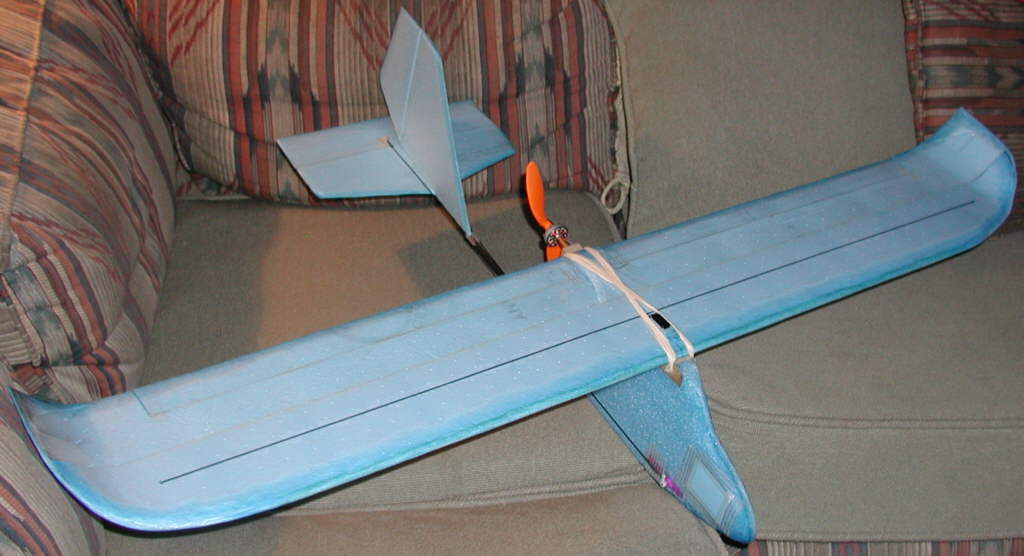
Friends,
I first built a KF variant stepped FFF wing, implemented as a dual layer on my HOOT with this second layer added on top of the deep flat plate wing, extending back only to the CG point at approximately 25% of chord. With the two layer thicker leading edge and stiffer wing, it handled very smoothly and predictably...
When I buily the MANTAs, I initially flew the first one as a flat plate wing. Later I built the second MANTA, and I added the front doubler panels to both top and bottom... but again they extend back to only about 25% of chord. With the nicely rounded triple thickness leading edge, the wing was less pitch sensitive, and had almost no flex, so it flew very nicely.
On the third SPINNER which I designed & built, I wanted the thicker leading edge and stiffness produced by the triple layer forward section. Since balance / CG is at 30% of chord, I extended the tripler layers to that 30% of chord, with an evenly rounded symmetrical leading edge. It flew superbly- far smoother and more predictable, with far less wing flex than the two previous SPINNERS with their flat plate wings. With the thick leading edge, there is no pitch sensitivity. It's a great aerobatic aircraft- by far the best performing of the three SPINNERS (-all of which are still flying.)
With these three designs in the air, I started looking into what others were commenting about using the the Kline-Fogelman step treatment on their RC designs. One of the discussions which caught my attention and interest was Doug Montgomery's fledgling KFm5 DLG design. I was looking for a way to get a clean, efficient glide while building a relatively uncomplicated wing with sheet Bluecor material. What was most significant to me, conceptually, was that if the step was placed on the top surface back at 50% of chord, that a lightly loaded wing could glide quite efficiently.
Heat forming and shaping the wing's leading edge & overall airfoil countours similar to an RG14 airfoil, and tapering the trailing edge down to ~1/16" thickness, as well as implementing my heat-contoured upswept wing tip sections did a lot to clean up the aerodynamics.... but the really sweet concept was that, contrary to 'conventional wisdom', having the substantial 'discontinuity' of the 90 degree step at the rear edge of the top panel did not impose the drag penalty that most have been lead to believe would be observed. In fact, a *REDUCTION* in drag may actually be the result, according to some.
I decided to get the new Kline-Fogleman variant airfoiled wing flying quickly, so I worked over a fuselage / tailgroup which I already had on hand in order to do the test flying. (I have several other single layer undercambered Bluecor wings already built to fly comparisons on this same airframe, so this seemed a good approach to get into the test flying and comparisons quickly.)
This fuselage may look a bit familiar to some of you; it's one of my Blue Beagle variants, with a longer tail boom and larger tailgroup menbers. It's been flying since early last July, but it went through a bit of upgrades earlier today.
I used the heat-forming technique (using the covering iron) to heat-compress and thin all edges on the bluecor tailgroup menbers to minimize drag. Then I set the iron's heat setting lower (after testing on some scrap to find the right temperature) and did the heat-forming on the AquaRider foam fuselage, too. The nose and the rear edge were thinned substantially to make the fuselage more aerodynamicly efficient.
An E-Sky 8 gram servo was set into the center of the wing just in front of the spars (which are at 33 % of chord) with the outshaft on the underside of the wing. I cut away enough foam in the wing mounting area to clear the servo / arm / linkage. DuBro Mini EZ connectors are used on the 1/32" birch ply aileron horns, so that slight changes in aileron camber can be easily tested.
The motor is a 21 wind GBv kit motor, Y winding termination, driven by a CC Thunderbird 9 ESC, running on a 2S Li-Ion 1250 mAH pack, turning an 8x6 GWS prop.
Flying weight is at 10-1/4 ounces, Wing projected area is 2.2 square feet, resulting in a wing loading of 4.66 ounces per square foot.
I had only about a half hour of failing light at the end of the day to get in a bit of preliminary test flying, with cold air and mild turbulence. (I have the aileron channel mixing back into the rudder at a 10% mix.) Handling is very smooth, across the spectrum from under full power in climb, to low power cruising to maintain altitude, to glide. The upswept wing tips are definitely providing the dihedral-like stabilizing effects on this wing; in smoother air, it'll be able to be flown hands-off a fair amount of the time.
Rudder alone still has very good authority with this wing planform. It's also fun to flatten out rudder turns by applying oposite aileron. I think this is going to be a fun wing to fly a lot more!!
Conditions late in the evening, just after a brief session of snow flurries, were not appropriate to do much evaluation of the power-off glide characteristics- that will have to await a more favorable flying day!
I'd really enjoy getting this wing on a light weight HLG fuselage, to see how it performs at an even lighter wing loading; but for now, I can swap wings around on this airframe, to do some of the comparisons between the K-F variant wing and the various undercambered single thickness wings which I already have on hand. I'll report my evaluation results.
(Further information on the heat-forming techniques are included in the SOARBIRD discussion thread on RCGroups, and in the KFm-5 DLG discussion thread.)

[Above]: New 46" span, 7" chord aileron wing with Kline-Fogleman airfoil being flown on an AquaRider fuselage BEAGLE.
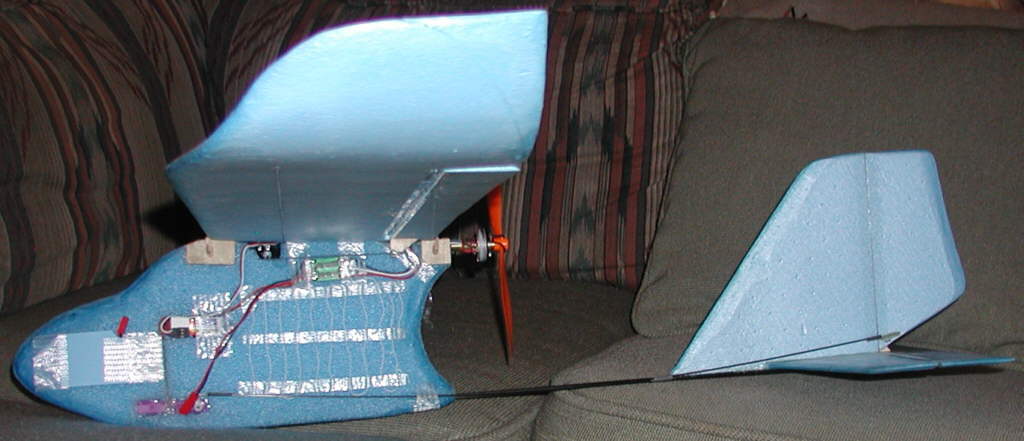
[Above]: Left side, showing most of the gear; wing uses 2-1/8" up upsweep starting just beyond the center 39-3/4" long spar structure.
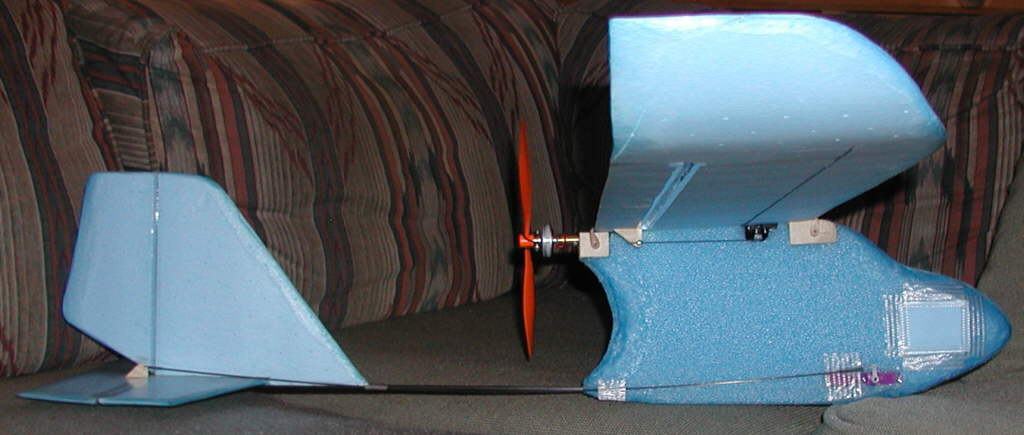
[Above]: Right Side
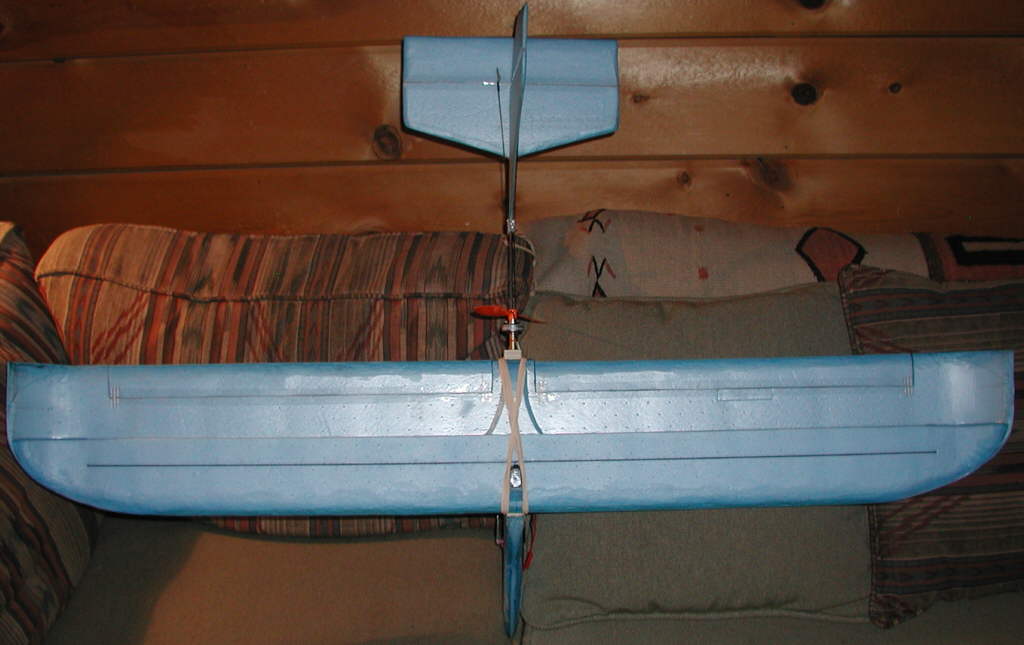
[Above]: Top side; Step is at 50% of chord, maximum thickness is 7.44% of chord, while spars are at 33% of chord. This wing is flying great with the balance at 40% of chord.
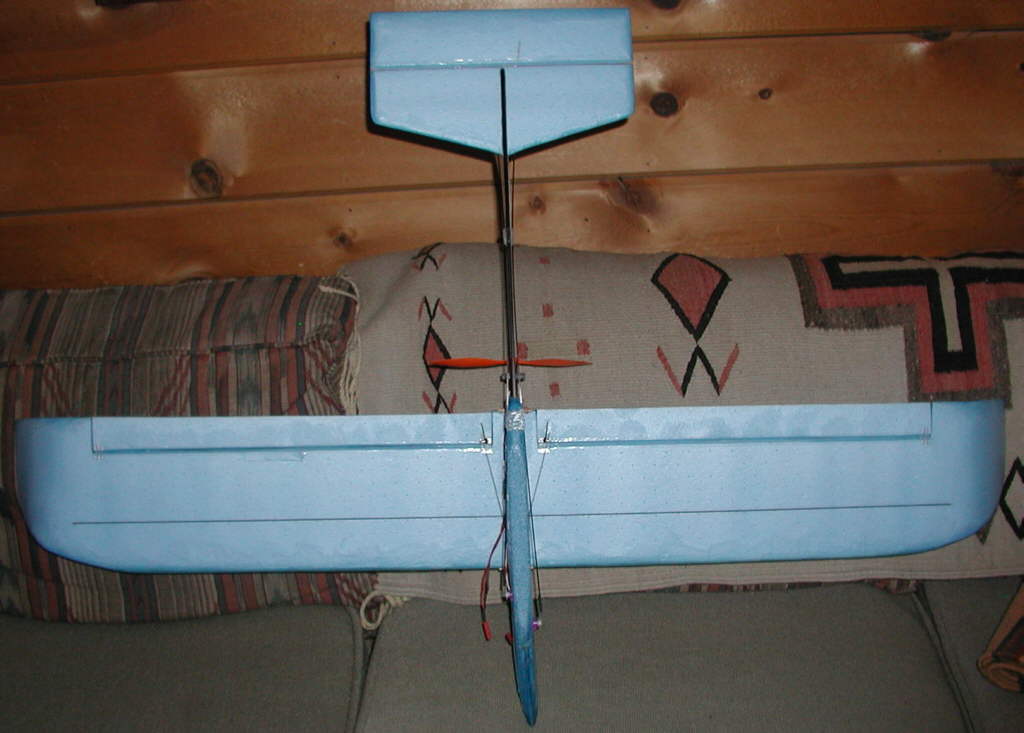
[Above]: Underside, showing aileron linkage; ailerons are 1-9/16" deep. 17-13/16" span each; wing spars are 1mm CF rod 1 meter long.

[Above]: Extensive heat forming of Bluecor can be done with a covering iron. This 46" span Glider wing with a Kline Fogleman modified airfoil started as a folded section of Bluecor, Then was shaped from there.
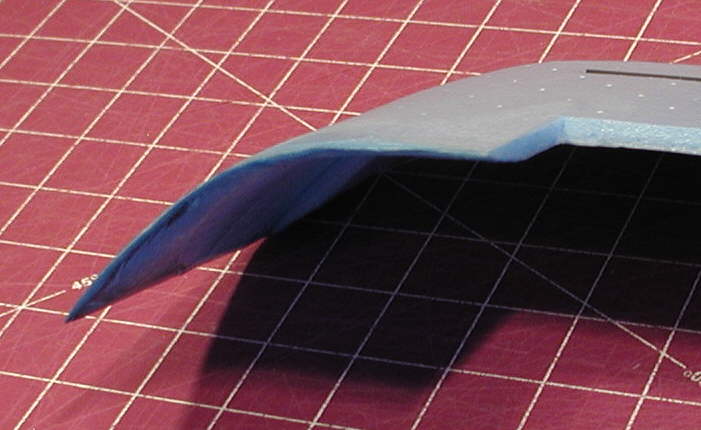
[Above]: Here's the trailing edge of the upswept wing tip, clearly ilustration how much foam re-compression and strengthening can be achieved with the technique. <1/16" thick trailing edges now, very strong, without any added weight

[Above]: This wing is just over 6% thick at the top step; the leading edge has been reshaped into a better airfoil by heat compressing the foam along the entire leading edge; center line of L.E is now at ~25% of total thickness.
I've discovered that a covering iron, set to just the right temperature, can be used to shape, compress, and heat-temper the Bluecor material. The result is a smooth transition into fairly thin trailing edges and leading edges without sanding away any of the material; instead, the foam is compressed & heat-condensed and tempered into a much firmer composition in the treated areas. the photos below show the results.
Being able to produce thin, strong leading and trailing edges on Bluecor aircraft parts using this new heat-forming technique shows great promise! I'm rather excited about the possibilities, to say the least. I've never heard / read of anyone using this technique before. I know I'll be using it on many designs from now on!
The first detail is to determine the right temperature setting for your covering iron. (I'm using an older iron with a flat bottom & fairly sharp edges to do the detail work on the aileron 'feather' contours, and it's working well for that.)
Experimenting and practicing on scrap will help find the correct temperature setting. (Somewhere burried in one of my cabinets / drawers, I may still have a temperature gauge for covering irons; if I can excavate that, I'll be able to post an actual temperature reading of the setting I'm using.)
I'll say this for now: the setting I'm using is well above what I'd use to attach Ultracoat / Oracover to a built-up structure; on this iron, the 2 setting is at 12 o'clock; while I'd use a setting of from 1.8 to 1.9 on the covering materials, I'm using a setting of close to 2.2 with this new Bluecor shaping technique.
If the iron is set too hot, then you can't control the effect- the surface of the material melts excessively before the heat penetrates the core; too cool, and the foam doesn't respond / compress / fuse properly. A bit of patience is needed to allow the heat to penetrate the core, for the iron to do it's job- it's fairly fast, but does take a bit of time to achieve a finished shape. Finding the right temperature setting is then a critical factor.
The next detail deals with technique; you need to press, rather than 'drag' or try to slide the iron on the foam to keep from distorting the shape. I find myself 'patting' the foam areas to achieve final finish shape; (continuous application of the iron is *not* the way to do it!
Just playing with some scrap to see how it handles will allow you to get the feel of it.
This technique is producing very nicely contoured / thinned / compressed / tempered / strengthened leading and trailing edges, which will minimize drag while increasing rigidness and durability of the Bluecor's edges.
I'm still working with the double faced Bluecor PP; I managed to squirrel away a good supply while it was still available locally. I don't have any of the pink or green that some are writing about using, so I can't comment on how this heat-forming technique works on those materials, but I'm expecting that a temperature setting can be found that will allow those materials to be worked with this technique, too.
I'll check the older BPHobbies 6mm Depron-like material I have on hand to see how it responds; my impression is that the core foam in that material seems to have less structural strength than the Bluecop PP....
[Update:] I checked the temperature at which I'm running my covering iron to do the Bluecor edge shaping; my Coverite 'Pocket Thermometer' is reading about 345 degrees F when placed in the center of the iron's lower surface.
[Update, posted April 6th to the KFm DLG discussion thread;] (Another menber commented): "Very interesting. The foam forming must take quite a bit of practice/patience. Good thing Bluecor is cheap Keep the pics and build info coming."
[BKS Response]: Actually, there was very little 'practice' involved; just a bit of playing around with a couple of pieces of scrap to get the temperature setting right. Then I just dove into thinning the edges of the tailgroup & ailerons for Soarbird III.
This KF variant wing was only my second project applying the heat-forming technique. PATIENCE is involved, mainly because heat doesn't penetrate into the core of Bluecor instantly. So you have to work progressively to end up with the results shown in the photos. I probably spent close to an hour doing all of the shaping on this entire wing once the spar structures were completed.
For the quickie builders who take pride in having a plane in the air flying in an hour from the time they start cutting foam, it would take a major mindset shift to invest this much time.... but for those who are looking to start with material like Bluecor, and end up with a more efficient glider wing, the time invested may show rewarding results.
I wanted to give the Kline-Fogleman airfoil concept a fair test, so cleaning up the rest of the aerodynamics as much as possible was a priority for me on this project. I still have several light, efficient built-up HLGs hanging on the ceiling with which to compare the flight characteristics of this new wing, so I'll be able to satisfy my own curiosity by the time I'm through putting this wing through it's paces.
I'll certainly report on the progress and flight testing results!
Gene B Asked: "Could you tell if this wing was able to 'hang in there' as slow as you other 8% underchambered wing? I assume the high speed was higher, with lower drag, but weight is up a tad as well..."
[BKS Reply, 4-8-2007:] More on the Kline-Fogleman Bluecor wing for the BEAGLES
Gene,
That's something I'll try to evaluate; flying conditions were marginal, so I did not have a chance to do the comparison yet. The ~42" span 7" chord undercambered wing is going to be hard to beat in gliding- especialy when we're carrying the weight of the motor and 120 gram battery pack...
But the KF wing promises to penetrate gusty / high winds easier, and handle high speeds and high power climbs smoothly without the 'ballooning' which undercambered wings can exhibit... so it may be a very good trade. But we still want the glide efficiency, too, so finding the 'magic' proportions & layout of a K-F variant wing which will offer the best performance in that category is the ultimate goal. This is the first experimental wing, and it's showing great promise- the layout parameters are very usable.
I'm curious as to what effect could be noticed by increasing the wing thickness another 1/16" = to 8.6% thickness on a 7" chord. (This could be done by using a 1/8" thich balsa strip at the step for the center 39-3/4" section.
The upswept wingtips are already showing very good handling characteristics which a flat wing would not have. It's relatively easy to roll up the tips once the spar structure is completed, and to then heat-temper the upswept tips so they'll hold their shape (with careful use of a heat gun) before hot-melt glueing the two layers together in the final shape. (I'm already liking the results that heat-shaping the edges with the covering iron is producing!)
[Posted to the 'Kline-Fogleman Flying Wing' discussion thread on April 8th, 2007:] With the top step at 50% of chord on a 7" chord wing, and the thickness at 7.44% of chord [1/16" balsa spacer added between two layers of Bluecor at the step] this wing is VERY stable with the balance at 40% of chord, and could be set up to be more responsive by simply shifting the balance back a bit more- possibly to 43% to 45% of chord - (IF there's adequate tailgroup area or a long enough tail boom / tail moment.)
Note: I did the first launch with added lead taped on the nose temporarily to bring the balance forward to 33% of chord, and it definitely flew nose-heavy; so I brought it in for a hand-catch, removed the lead to take balance back to 40% of chord, and relaunched; it's handling better there, but could still be more efficient and responsive if the balance were back a bit further. Considering that the 'high point' [KF top step] of this wing is back at 50% of chord, best glide efficviency may be back closer to 45%. I'll be exploring this soon. (I'll install the C.F rod spars back at 40% of chord on the next wing, anyway...)
WINGNUTT commented on 4-9-2007:
"I have really become a fan of the addition of a slope behind the step. My current test design uses a step peak at 40% chord which slopes back to the wing surface at 50% chord. With a step height of 7.5% thickness (measured from peak of step to other wing surface) this yields a slope angle of about 60 degrees. From what I can see, all of the KF properties are still held, but with reduced drag. I guess this is no longer a KF as there is no longer a hard step. Another great benefit is that in most cases, a spar is no longer required if the step is left hollow as it creates somewhat of a ‘D-box’ leading edge."
[BKS Reply]: Wingnutt,
Thanks for this report. Reduced drag is GOOD!! - Especially when we're speaking of gliding performance on HLGs & DLGs. (The Beagles really love to thermal, too!)
I should be able to quickly & easily add a sloping filler piece behind my step to test - (although the step is back at 50% on this wing for now) - just tape it in place & fly. I'll post a report when I do get a chance to test-fly my wing without, & then with it.
[CLICK HERE to jump to this dicuussion thread on RCGroups]
[Posted 4-11-2007 to the RCGroups Beagle discussion thread:] BEAGLE MORPHING: the next test prototype
Friends,
The new Kline-Fogleman variant wing is very promising, but weather here in the high rockies has not been suitable for further test flying... while some of the rest of the country is into a different version of spring, we're getting substantial snow, and winds are running into the 'small dog warning' category. (It must still be 'building season...)
I'm designing a new, sleeker pusher-powered fuselage for this new wing design, drawing upon what's already proven to work from the previous Beagle variants; so I'm scheming on putting a Beagle fuselage on a 'diet' - reducing the height of the body / fuselage from the present ~6" maximum, down to a maximum height of about 3.5" of Aquarider (or EPP) foam to reduce both drag and weight.
This depth of fuselage would still allow swinging up to a 6" prop, such as the GWS 6x3 DD prop. A GBv kit motor wound with 10 wraps of 24 Gauge wire [Y], running on a light weight 2S LiPoly pack can produce over 12.5 ounces of thrust at a current draw of 6.2 Amps with this prop. Prop pitch speed is around 35 MPH, good for this design. (The data on the 5" props did not look as good to me, so I'm designing this one to stay with the 6" props.)
So the light weight and inexpensive CSRC 2S 800mAH budget packs which I have on hand should perform fine in this trimmed-down BEAGLE variant, with a substantial weight reduction from the 2S 1300 packs my other Beagles are flying now.
I've cut the foam nose extra-long, and installed 24" of .157 diameter C.F. tail boom tube into the lower surface of the foam, with 10" in the foam, 14" extending back to the tailgroup / elevator hinge line.
The 3mm Depron for the lighter tail group is being shipped my way now; once it's here, I'll build out the light weight tail group, install the rest of the gear, determine where the battery needs to be for proper balance, & remove the excess foam from the nose and heat-form it into an aerodynamic profile. (The classic BEAGLE silhouette may suffer a bit from this trimming down, but the result should glide more efficiently, and be VERY aerobatic, too, while still retaining a reasonable amount of stability.
I'll post photos, detais, and hand-drawn plans as soon as the test flights are complete.
Posted 4-13-2007 to the Beagle discussion thread:
I had a chance to fly the first KFv flat-built aileron wing yesterday a bit on the BEAGLE in strange light conditions, but less winds... (flying between snow squalls!) So far, I'll report that it does not handle as easily in tight maneuvers & in slow high angle banking turns without flkying both rudder and ailerons - (there's simply not enough dihedral offered by the short upswept tips)- and it simply is not designed to handle the higher-alpha attitudes like a good 8% / 35% undercambered wing.
It definitely is able to penetrate high winds FAR better - (being a low camber airfoil), and can handle high speeds smoothly, but maneuvering well at low speeds does require smarter thumbs, flying rudder as well as ailerons. The way I built it, this first wing would make a superb slope flying wing. The wing loading might be bit high on this BEAGLE fuselage ; it may perform better when I get the trimmed-down / lightened version fuselage completed. (EDIT: It might also be an issue with the higher profile, and the higher wing incidence angle relative to the tailgroup.)
The rudder is definitely very useful and needed with this low-dihedral wing for clean flying, so it's not the best wing planform for a HLG (or any other design) built without a rudder, and it's not yet evolved into the "best" wing design for a novice. ;)
But it does nice rolls and flies inverted well, so there are some positives in the trade-off. This IS only the first prototype, after all, test flown on a different Beagle fuselage...
Thoughts on variations: Adding a 3mm depron panel to the undersurface back to 40% of chord might be the trick to increasing the low speed maneuverability & softening the stall characteristics. The other trick might be to reduce the span of the center flat section to ~70% of the span, and build in more polyhedral (or eliptical up-sweep) in the wing tip sections to increase the tight-area handling authority, if that type of flying is desired rather than smoother gliding performance.
Adding in the swept-back filler behind the top step, as Wingnutt speaks of, should also reduce drag and thereby improve the airfoil's glide. And thickening the spacer under the top step from it's present 1/16" thickness to 3/32" (or 1/8"?) thickness would effectively raise the effective 'camber line' of the airfoil a bit higher, which should increase lift. (By also adding in the swept-back filler behind this taller top step, there should not be the 'drag penalty' that would result without the filler...)
All of these various design aspects may be implemented on the next prototype wing, while keeping the building techniques as straight-forward as possible.
Friends,
I completed the new "SLIM BEAGLE" earlier today, and got it out as the winds were building to 12 to 15 MPH for the first flights. Flying weight is now at 8-7/8 ounces, flying the Kline-Fogleman variant wing, with a 2S 800 mAH battery in the nose. There's still a minimum of 1" of EPP foam around the front of the battery compartment to protect it during rough ground landings. (Further slimming and streamlining could possibly be done... but today, it was TIME TO FLY!!! And Oh, Boy- does this puppy FLY!!!
The Bluecor wing could be thought of as being somewhat / roughly comparable to an RG-14 wing, as far as thickness & camber. I find it flies very nicely when both ailerons are drooped about 3/32" from the bottom.
This downward reflex just in front of the trailing edge is somewhat similar to the RG 14 & 15, and the SD6000 series slope glider airfoils.
I moved the Aileron servo, linkages, & control horns to have the linkage on the top side of the wing, and kicked up the total travel on the ailerons while I was at it... and the results have me GRINNING for sure! Roll rate is now Very Satisfying!!!
Please understand: this KF variant airfoil is not really a slow speed airfoil, although it slows down nicely for hand-catches; and it would NOT be suitable for indoor flying... it likes to cover ground and cruise, both under power or in the glide. (If you slow it down too much and start to 'mush' it, it simply drops out of it's ideal performance envelope. When flown within that performance envelope, it's SWEET!!!
The 6x3 prop on the 10 turn [y] GBv kit motor allows this bird to climb like the proverbial homesick angel; it can be flown like a light weight hotliner to a certain extent. Speed is excellent; when the Beagle with the undercambered wing was tossed into the air today after flying 'SLIM', there was no comparison; winds were too strong for the Beagle, and it was quickly appearant that it was time to get him down again! In contrast, SLIM could climb out strongly and smoothly- no buffeting noticed at all, and the pitch attitude was very smooth and controllable.
The wing saddle on this puppy is set at about 1-1/4 degrees positive, relative to the tailboom and tailgroup; the motor incidence is set at zero, relative to the wing saddle. This results in a very neutral power on / power off attitude.
When floating low & slow just above ground level at close to stall, if full throttle is applied quickly, SLIM will dip his nose a bit as he quickly gets moving out to climb back up to altitude again. (I've seen a lot of E-powered gliders that handled a LOT worse when full power was applied to a aircraft at close to stall speed; but there's much better mannered handling with this SLIM puppy!
Yes, designs do get morphed - sometimes dramatically... (look at the 'Smart Dart' discussion thread for a recent example of morphing...!) This puppy really doesn't look much like a Beagle at this stage, and he certainly doesn't fly much like the ~30+ Beagles I've helped people build over the last couple of years... And I'm REALLY enjoying the present result of the ongoing 'morphing' process!
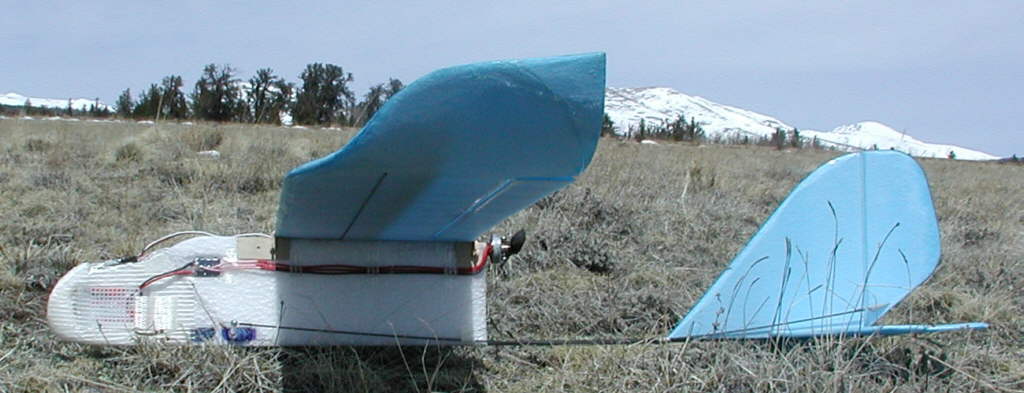
[Above]: EPP "SLIM Beagle" foam fuselage is 3-3/4" max height, 3/4" thick; balancing nicely with a 2S 800 mAH CSRC Budget pack. Flying weight 8-7/8 ounces.

[Above]:This Slim Beagle flies more like a hotliner under power- good rolls, inverted, & inside & outside loops. Handles winds MUCH better than the undercambered wings, and glides fairly well, too!
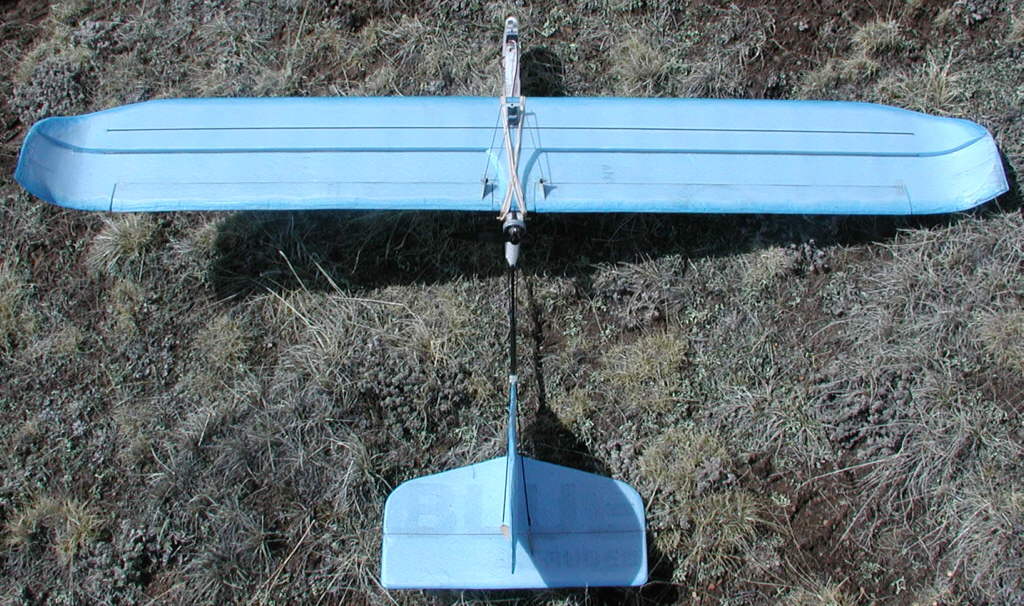
[Above]:KFv wing is 46" projected span after shaping upswept tips (starting with 47-1/2" foam.) Chord is 7". Single aileron servo used- working well.
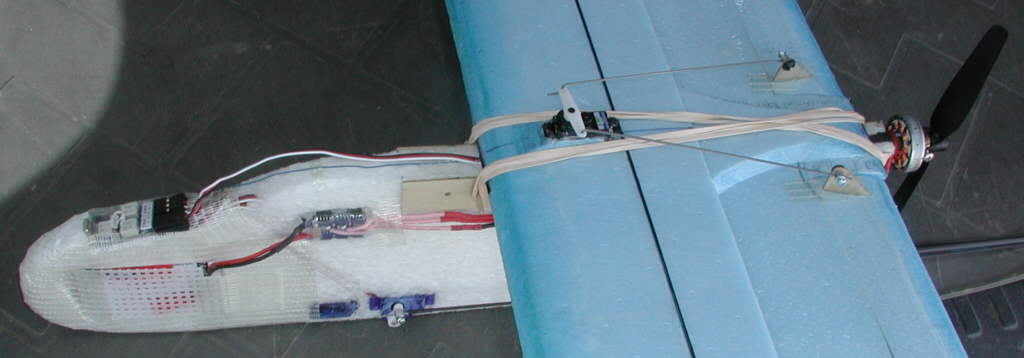
[Above]:This fuselage can fly 7" or 7-1/2" chord wings by simply moving the front peg. Rx is on top of nose- easy access to plug in aileron servo lead when mounting wing
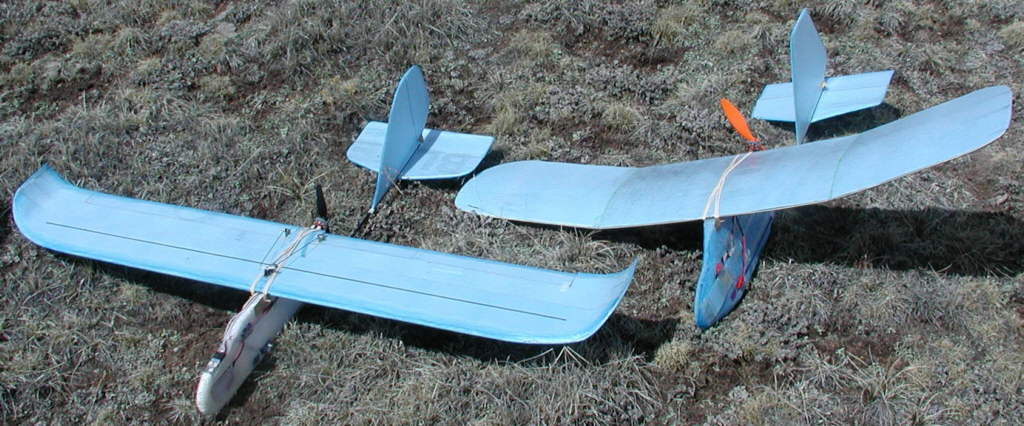
[Above]: On the left, the new "SLIM Beagle", flying 6x3 prop; on right, taller fuselage version flying 8x6 prop, undercambered wing
Friends,
Slimming down / reducing the height of a Beagle's fuselage for less drag is related to the motor you are going to run on it, and relates directly to prop size. I'm staying with 2S battery packs to minimize weight; if you do that, too, that means you will be looking for a higher Kv motor.
If you're not into winding your own motors, then a posible option that's readilly available is the GWS (2805-15?) - [the lightest of the three small GWS brushless motors.] It performs well swinging a 7x4 prop.
That would have you laying out your slimmed-down Beagle so you have clearance for that size prop- at least 3-5/8" of space from the center of the prop shaft down to the tail boom. So you could make a foam fuselage out of a piece that's a maximum height of about 4" to 4-1/8" (depending upon how much positive wing incidence you want to build into your wing mounting.)
I have a foam fuselage on the new SLIM BEAGLE that's 15-1/4" long overall at this time; that gives 1" of foam in front of the front end of the battery for protection, and about 3/4" of foam below the lowewr front corner of that battery. (I started with a longer blank until I could determine the battery location required to properly balance the new KFv wing, then carved away the excess.)
By insetting the radio receiver lower into the foam than I did at first, this puppy's nose could be slimmed down a bit more; but contouring and streamlining may be enough for my purposes on this one- it's not designed to fly over about 40MPH. If I were building another 90 MPH sloper, I'g focus more on streamlining for those airspeeds! (I already rounded the front profile smoothly, thinning the sides of the nose, as well as extensively thinning the foam fuselage's trailing edge just in front of the prop- a key area for reducing drag and smoothing airflow to the prop. )
The fun continues- more soon!!!
{Posted April 18th, 2007:]
Friends,
I did a quick application of visibility on my 46" span "Slim Beagle" Lite Hotliner today- Fuscia and Black are the primary colors!
It'll definitely show up against blue sky or clouds now!!
The paint added about 1/2 ounce to the flying weight... ah, tradeoffs... !!!
This design needs a designation, to keep the confusion to the minimum. I'm still referreing to it as the "SLIM BEAGLE" LITE HOTLINER .
[Ahhhh, but pink?)
HEY- it's a hotliner- it NEEDED hot colors!!
Note : Winds were up to 33.7 MPH on the wind meter at Kenosha Pass just after 3PM today when I finally got there, so this lite bird stayed in the vehicle, while I flew my Predatorized BEE for a while... another day!

[Above]: This "Slim Beagle" Lite Hotliner now has enough color for visibility in the air!

[Above]: Black shows up well against the sky from below- especially as you begin to 'speck out' in a good thermal. the Fuscia is very visible down low, allowing irreverent hotliner-style aerobatics.
Added 4-23-2007
Friends,
I got in some GREAT flying with the new 'Slim Beagle' with it's Kline-Fogleman variant wing yesterday. It is riding light thermal lift *very* efficiently. At 46" span and 7" chord, it was up to the visibility limits, 'specked out' many times, and had to be flown back down out of the lift.
A fter flying the thermal lift for the morning, we moved to do some slope flying on the South facing side of Kenosha Pass, since the light winds were out of the south.
(A Flying Buddy had a recently completed a lightweight Wild Wing that he wanted to test in the slope lift.) The lift was light and cyclic when we starterd flying, and the Wild Wing, at 10-3/4 ounces flying weight, could not stay up for very long at a time when the wind / lift cycles died. But the new Slim Beagle, with the KF variant wing, could stay up far more easily, and flew the light slope lift well.
About every 4 or 5 minutes, a wave of stronger lift and winds would cycle through the area, and at times later in the flying session, the winds would be peaking close to 20 MPH. Although the wing loading is only 4 Ounces per square foot, the new KFv wing on the Slim Beagle could penetrate these stronger winds well when the trim was kicked forward for a more nose-down attitude, working back & forth across the slope at substantially higher speeds. The wing is stiff enough, and the .157 diameter CF tubular tailboom is rigid enough to handle the flight loads nicely.
The Wild Wing was happier with the stronger lift conditions, too, and was flying the ~20 MPH peak wind speeds happily without ballast... but when each stronger lift cycle would die down and the following cooler air would begin to move through, it would be time to land it, while the Slim Beagle could work the soft lighter lift and stay up.
~~~~~~~~~~~~~~~~~~~~~~~~~
This wing may not be the best newbie wing for a Beagle; most novice pilots will be more comfortable with a higher dihedral or polyhedral wing, with it's ability to be set up & trimmed for hands-off stability.
But it just might be a *very good* Next Generation wing for a Beagle, or a great wing for your next BEagle build. (If you have a Beagle with the smaller tailgroup and shorter tailboom on which you will fly a new wing, you might consider either keeping the total wing span down at 40".)
Another note: this wing will fly best both at high speeds and while gliding with a low incidence / angle of attack relative to the horizontal stabilizer. I have barely 1-1/4 degrees of positive incidence on the wing mount saddle on the new SLIM BEAGLE; my observation is that this wing glides better at this incidence than it did on ther Blue Aquarider fuselage with it's taller profile and +2 degrees wing saddle incidence.
The covering iron heat forming techniques work well on the Bluecor edges to thin and firm them, and on the AquaRider foam fuselage. [It does not work on EPP, as the EPP melts and sticks to the iron at temperatures before the EPP foam can be usably heat-formed or compressed.] I have not tried the heat forming techniques on Depron or the BPHobbies foam yet.
It's easy to build the two-layer KFv wing nice and straight, since you build the main inboard part of the wing flat on your flat building surface. The wing tips get shaped last, after cutting away the rounded front edge corners. The rolling up and heat-tempering of the wing tips happens after the main inboard section is already glued solidly together, so it can't get out of alignment.
One aspect that has to be watched in making thin trailing edge ailerons, is that the extensively thinned trailing edges of the ailerons tend to like to shrink upon cooling if you don't hold some 'stretching' tension as it cools. Yes, it certainly can be done- I did it succesfully on my first wing of this type. But three work-arounds could be used to make it easier to end up with a good flying wing:
1> After the front double layer section is glued together and the spar material in place, do the wing tip rolling & tempering & glueing next. Then do the trailing edge and wing tip thinning / shaping BEFORE the ailerons are cut away from the wing LAST. This should have the rest of the wing helping keep the aileron's trailing edge from shrinking. If you do get any slight shrinkage stress in the ailerons, the hinge line edges can be sanded to compensate once the ailerons are finally cut away. This works for me.
2> You could optionally add a 1mm CF rod with foam-safe CyA glue along the bottom outer edge of the aileron panel before shaping, to hold a thin clean line that can't shrink or distort. Optionally, a thin piece of bamboo could also be used here; your option.
3> You could use a piece of light 1-1/2" wide x 1/4" thick tapered balsa aileron stock for the ailerons, and forget about making the thinned Bluecor ailerons completely!
~~~~~~~~~~~~~~~~~~~~~
I've cut out a second folded double-layer Bluecor wing now, and I decided to do a slightly tapered planform. The center chord is 7-1/2", the tip chord is 6-1/2". The leading edge is still the straight Bluecor fold. I've cut the top panel at 45% of chord, at a rearward-sloping 45 degree angle. I'm planning at this time to use either a 1/16" thick or 3/32" thick balsa strip at the top step to get the wing's total thickness thickness to ~7.5% or 8% of chord, and will also again use the pair of 1mm x 1M CF rods applied on the top and bottom surfaces as the spar structure. I'll locate the spar cap rods at about 38% of chord this time; I'm expecting the ideal balance point of this wing to be close to there.
~~~~~~~~~~~~~~~~~~~~~~
[Posted 4-23-2007:]
The wing chord is tapered from 7.5" at the center to 6.5" at the tip
UPDATE NOTE:: IMPORTANT!!!: There are strange handling characteristics to the step if it's angled... The top KFv step is BIING RE- located at 50% of chord; a square 90 degree step provides the best handling to date! DO NOT SLOPE the step' cut- keep it square at 90 degrees!
The balsa center spacer is still 1/16" thick, just under the rear edge of the upper layer, with a square trailing edge aligned with the upper bloecor layer. This results in a wing that is 7.5% thicck, relative to the average chord.
1mm diameter CF rod spar caps are now 37-1/2" long; the core balsa strip is 35-1/2" long, tapered to zero thickness over the last 1" on each end
The upswept wing tips are formed in the last 5-1/4" of Bluecor material at each wing tip
The leading edge was not thinned as much as wing #1 to start; further shaping / thinning NEED TO BE done; this is obvious now after test flying.

[Above]: After cutting out the wing blank, the center balsa spacer strips are cut and glued in place; I used foam safe CyA for this step.

[Above]: Next, the upper layer is glued to the balsa spacer ONLY; I used 5 minute epoxy for this step. The collection of old Gel Cell batteries are being used to weight everything down flat while the epoxy sets.
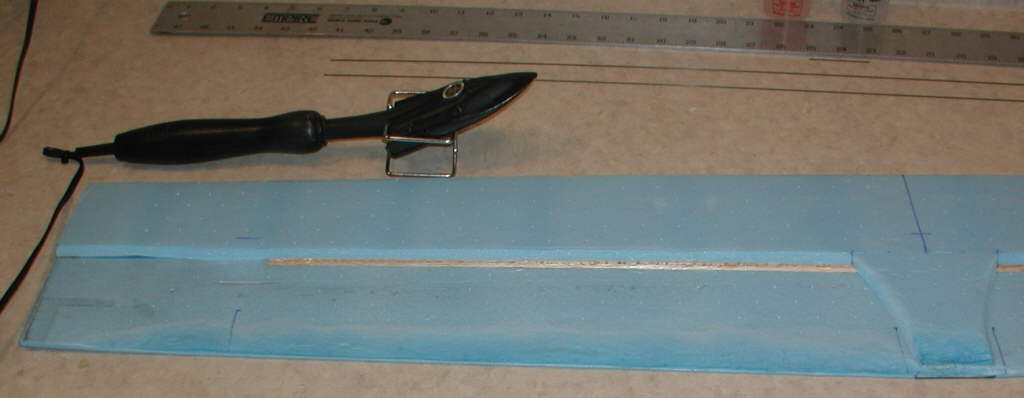
[Above]: Thinning of the Bluecor trailing edge is begun; (I later decided to use light balsa aileron stock rather than the Bluecor Ailerons, so I could have skipped this half-hour long process.)
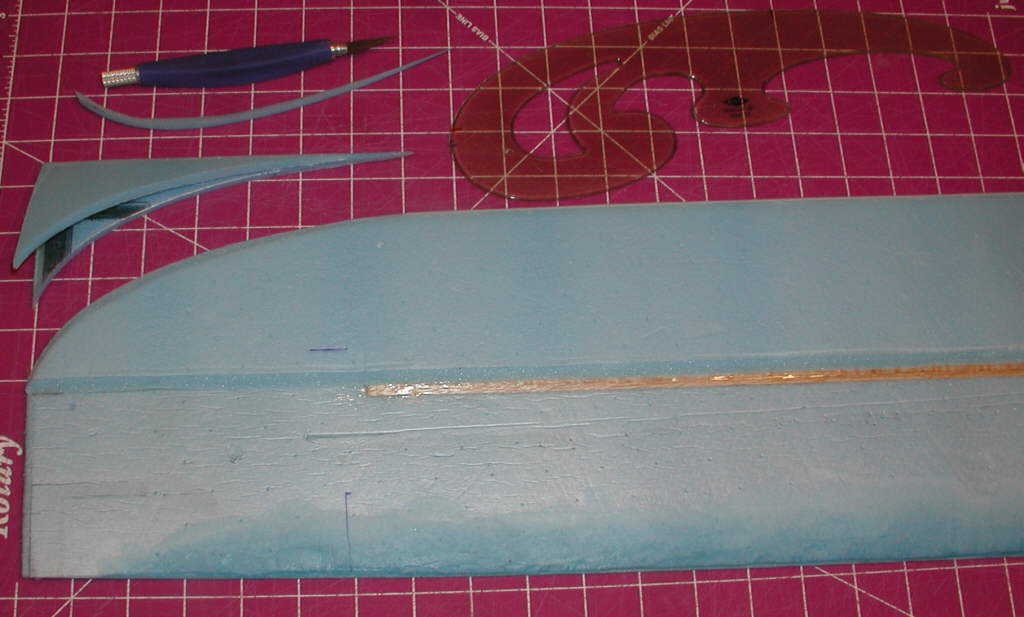
[Above]: A french Curve was used to trim back the wingtip leading edge.
Install the cap spar rods next, one at a time. (I lacated the spar cap rods at 38% of chord on this wing, since I expect this wing to fly well when balanced about there.) Draw a shallow groove with a ballpoint pen where the rod will be glued, being careful to not cut the Bluecor's surface film. Then 'woodpecker' a line of holes along the bottom of that groove. Next, apply a line of thin foam-safe CyA glue in the groove, and set the spar cap rod in it. Weight it down flat while the glue sets.
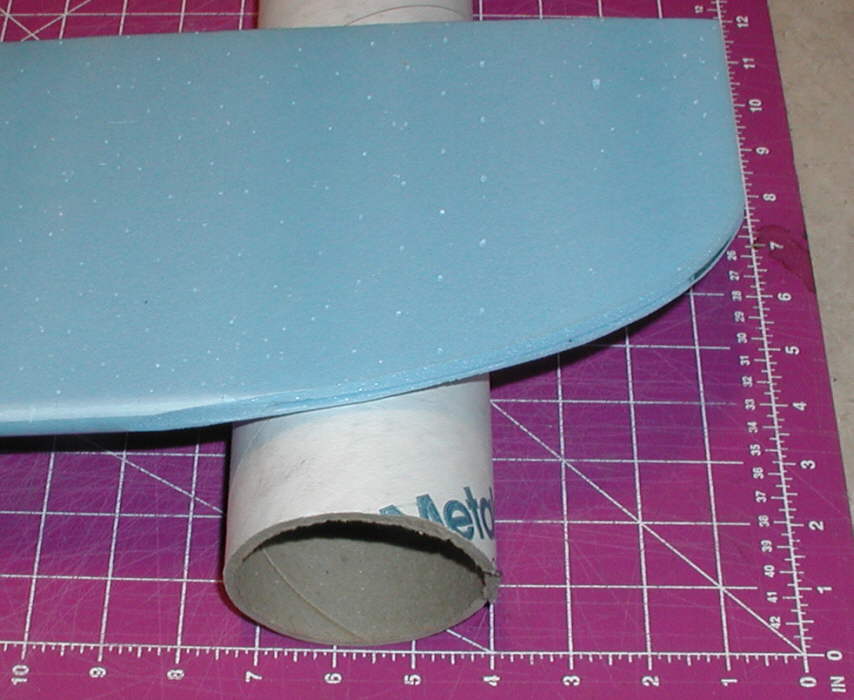
[Above]: Once your spar cap rods are glued in place (not shown in this photo) roll in the upsweep at each wing tip. I roll the bluecor over a 3" diameter tube for a smooth upsweep.
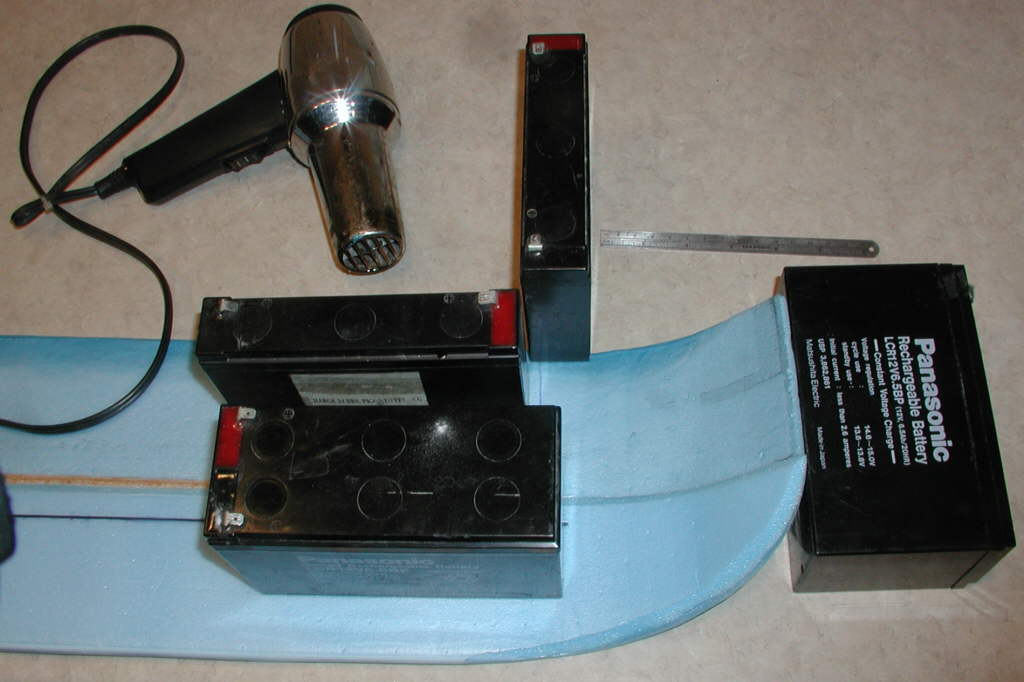
[Above]: Use a heat gun to 'temper' and firm the bluecor upswept tip areas while keeping it supported at the desired amount of total upsweep at the end; I'm using 2-5/8" of upsweep off the work surface on this wing build.
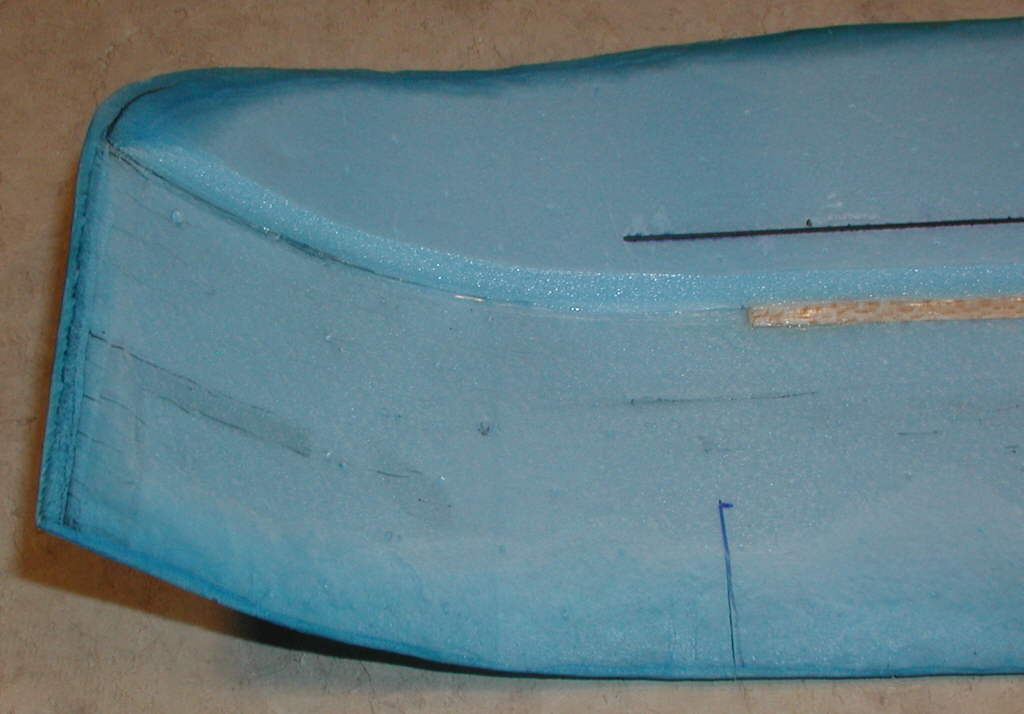
[Above]: Once the layers of Bluecor are shaped and heat-tempered in thwe wingtip areas, trim away the excess upper layer foam as appropriate. Then use hot melt glue or epoxy to glue the upper layer to the lower layer. Once glued, use the heat iron to heat-form the wing tip edges.
Use the heat iron to also round down the upper surface of the wing's leading edge to form more of an airfoil shape. The underside edge is also slightly shaped upward; the idea is to have the new leading edge at about 25% to 30% of the wing's thickness, so it will generate more lift and penetrate winds mre cleanly. Avoid forming too sharp a leading edge, as it will result in greater pitch sensitivity.
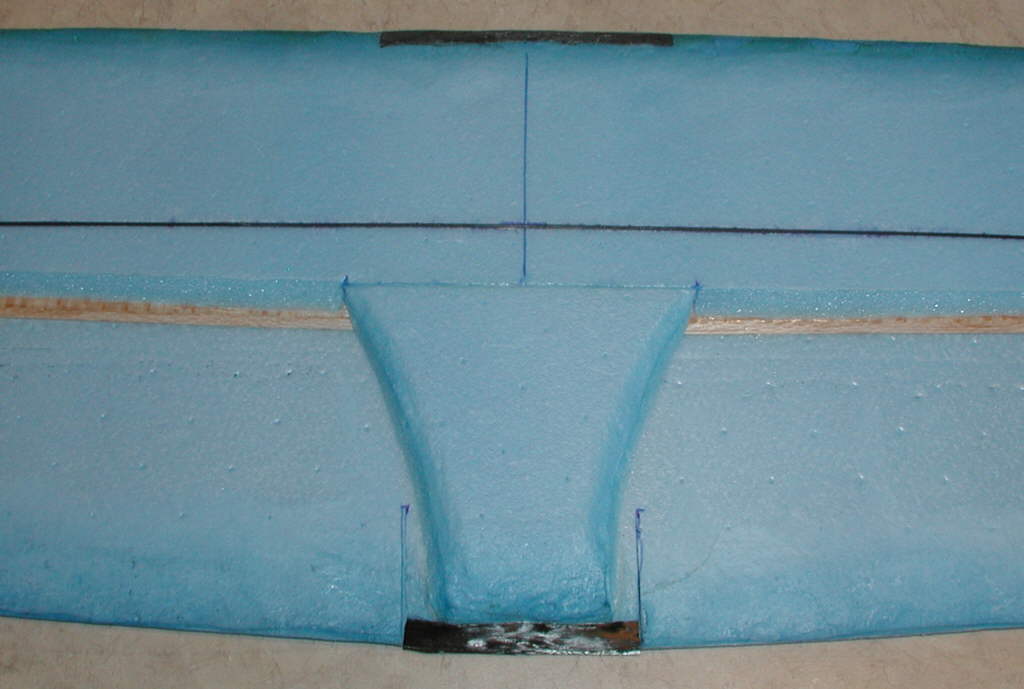
[Above]: A rear center section doubler has been glued in place and then heat-formed / contoured. One section of 1mm CF ros 2" long, which had been cut off of one of the cap spar rods, was glued along the bottom trailing edge of the center section of the wing before the heat forming was done von this section. Then some Carbon Fiber 'tow' was wrapped around the trailing edge, ironed on, and glued in place with foam-safe CyA glue.
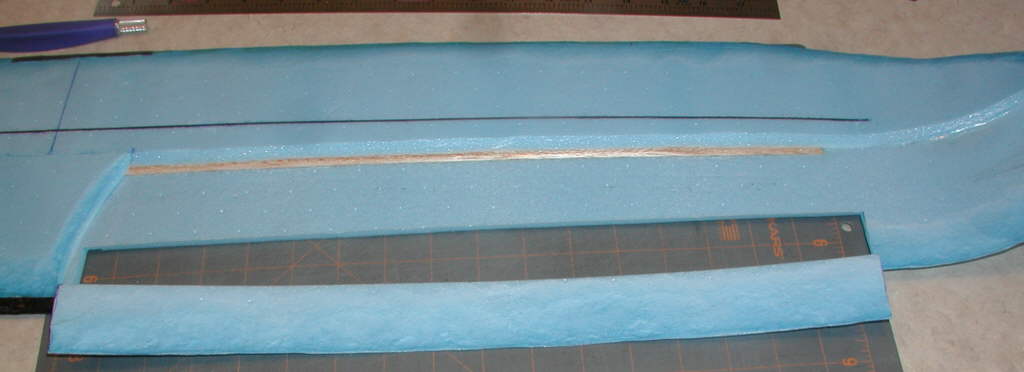
[Above]: Cut away the Bluecor ailerons - or the openings for the Balsa ailerons if you are going that route. Note that when I cut away this aileron, there is some up-curving, due to the heat affects on the upper surface of the Bluecor. While you can remove this curvature by working carefully with the heat iron, it's a touchy job; I decided to use light balsa ailerins, 1/4" thick x 1-1/2" wide, on this wing instead.
After beveling the leading edge of the balsa ailerons and sanding the aileron hinge line on the Bluecor wing to match, I made a pair of 1/32" birch plywood control horns which are than glued to the entire inboard end of each aileron. (See photo below.)
I had a bit of time yesterday afternoon, so I threw together this wing; it's 33" span x 7" chord- identical to the wing size on all 30+ of the 'EPP Beagles' that have been built in this region over the last 20 months; I chose this size for performance comparison purposes. However, due to the extra material and aileron servo & linkage, there's a weight increase of about 2 ounces on the new KF Variant wing... (the origional undercambered wing was only 1-3/4 ounces.)
I wanted to try another thicker KF variant wing, using the double staged step technique. This approach actually results in a 10.6% thick wing at the maximum thickness point at 35% of chord. (The DANCER wing, in comparison, is only 7.5% thick.)
Photo # 3 below shows the placement of a 3-1/4" wide 'spacer' layer of bluecor already mounted in place. This effectively produces a secondary staged step at about 70% of chord- the rear edge of the center Bluecor spacer layer.
Since I actually wanted to test-fly a wing with the primary step at 50% of chord, but with the maximum airfoil thickness at 35% of chord, I added in a 1/16" thick strip at the 35% location on top of the center spacer layer. (The photos should clarify both the simple layup process, as well as the resulting airfoil shape.)
Prior to closing up this folded wing, I rolled a bit of under-camber / curvature into the underside of the upper forward layer, to achieve a nicely curved upper forward surface to the airfoil.
ALL assembly was done with low temp hot melt glue; this made for a very fast build! There's about one full stick of glue in this wing- a fair trade for the speed and ease of construction. (The aileron horns were the only thing glued in place with foam-safe CyA glue.)
I first flew this wing last evening on one of the classic "EPP Beagle" fuselages, as shown in photo # 2 below... but the balance wasn't right when first mounted on that fuselage's wing mounting platform, so flying this new wing was a bit of a handful... fun, but not 'dialed in' - not at all suitable for a pilot with novice level skills. (The DANCER wing also was less than great when flown on that fuselage for similar reasons, so moving the battery to shift the balance substantially would have been necessary for both of these KFm wing upgrades.)
After 'sleeping on it', I woke up with two changes to make quickly: adding the wing tip plates on the wing, and installing this new wing on the second generation "Slim Beagle" fuselage.
Oh, MY, what a fine and pleasing difference!! The Slim Beagle has a bit hotter wind motor, turning a 6.3x3.5 prop, for a much more suitable airspeed for this wing. Add in the wing tip plates, fine-tune the balance, and suddenly, this "HOTDOG" wing comes alive!!
It climbs smoothly & predictably, rolls cleanly, loops nicely- both inside & out, of course- and flies inverted with only modest forward pressure on the stick.... not too shabby for a ~ flat bottomed wing! The power-off glide is fairly respectable, while the slow speed landing handling is docile and very managable- just what a novice pilot would love!
I had purposely left the folded leading edge alone, so for a little while longer it's still shaped like the standard fat round profile of the FFF's fold. I'm certain that shaping the leading edge would further improve the handling. The trailing edges are also full thickness- no thinning or shaping done to them at all yet; doing so should further improve the handling and glide efficiency of this quick-build "Hotdog" wing, but I wanted to do the changes in simple steps, test flying after each change, to evaluate the progressive contributions to the handling performance.
Other than the final wing shaping / streamlining, I can easily see myself increasing the motor power output- this wing can easily use a lot more! I may start by simply going to flying a 3S LiPo in place of the 2S, re-adjusting the prop size & pitch to get the performance this wing can deliver.
(No, it's definitely not your Grandmother's Beagle anymore!)
The Fun Continues!!!
